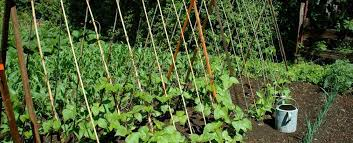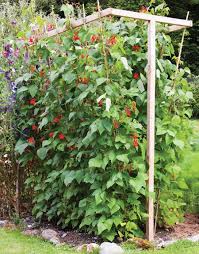By Benedict Vanheems
Growing climbing vegetables like beans, peas, and cucumbers can be a rewarding experience, especially when you provide them with the right support. Elevating these plants off the ground not only maximizes your harvest from a small garden space, but it also makes harvesting easier, reduces the need for weeding, and creates a beautiful, functional garden feature. Whether you opt for off-the-shelf structures or build your own, there are plenty of options for creating sturdy, effective supports. Here’s a guide to help you get started.
Simple Supports: Canes, Poles, and Stakes
One of the easiest ways to support climbing vegetables is by using stakes, poles, or bamboo canes. Simply insert these into the soil at the base of your plants. This provides an immediate vertical surface for vining vegetables to grip. While some plants will naturally climb, others may need a little help, so you might have to tie them to the supports in the early stages.
For runner beans, consider arranging canes or poles in a triangular formation, or a traditional tripod shape, which is both functional and visually appealing. Space the poles evenly, then tie the tops together with twine, wire, or string. This setup is perfect for peas and beans, while larger, sturdier poles are better suited for heavy climbers like squash and melons. For a more rustic look, you can use natural poles like willow or hazel.

Trellising: Flexible and Attractive
Trellises are another great support option for climbing vegetables. They’re versatile, easy to build, and can be positioned against walls, fences, or as standalone structures. To create a modern look, you can secure a sheet of thick galvanized wire mesh between two frames made of wooden battens. For a more natural feel, tie lengths of bamboo canes together to make a simple, small-scale trellis, ideal for individual plants like squashes or marrows.
Trellises can also be added to your garden design through online planning tools. These platforms let you visualize where to place your trellis structures for maximum impact.

Building the Perfect Bean Frame
A well-constructed bean frame ensures that the pods hang outwards, making them easier to spot and pick. Plus, it prevents the vines from growing into a tangled mess. Here’s how to make your own:
Materials Needed:
- 2x 32-inch timber pieces (2in x 2in)
- 2x 5-foot timber pieces (1in x 2in)
- 2x 7ft 4in timber pieces (2in x 2in)
- 12-14 bamboo canes (7ft)
- Screws (4-inch and 2.5-inch)
- Drill, sandpaper, screwdriver, wire or string
Instructions:
- Sand any rough edges off the timber pieces.
- Assemble the top of the frame by screwing the 5-foot timbers to the 32-inch pieces. Drill pilot holes to prevent the wood from splitting, and secure with screws.
- Attach the top section to the 7ft 4in uprights using the screws.
- Dig holes for the uprights, then place and secure them in the ground.
- Insert the bamboo canes into the frame at equal distances. Tie them together with wire, twine, or string to keep them in place.
- Finally, plant your beans at the base of each cane and watch them climb!
Conclusion
By using these simple, yet effective supports, you’ll ensure your climbing vegetables thrive. Whether you use poles, trellises, or build your own custom frames, these structures help maximize space and yield, allowing you to grow more vegetables in less space. Don’t be afraid to get creative with your supports! Share your ideas and experiences, and let’s continue to inspire each other for better gardening. Happy gardening!
